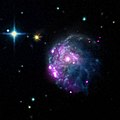NGC 2276
| Galaxie NGC 2276 | |
|---|---|
 | |
| NGC 2276 & NGC 2300 (l.) | |
| AladinLite | |
| Sternbild | Kepheus |
| Position Äquinoktium: J2000.0, Epoche: J2000.0 | |
| Rektaszension | 07h 27m 14,3s[1] |
| Deklination | +85° 45′ 16″[1] |
| Erscheinungsbild | |
| Morphologischer Typ | SAB(rs)c[1] |
| Helligkeit (visuell) | 11,3 mag[2] |
| Helligkeit (B-Band) | 12,0 mag[2] |
| Winkelausdehnung | 2,75′ × 2,6′[1] |
| Positionswinkel | 20°[2] |
| Flächenhelligkeit | 12,8 mag/arcmin²[2] |
| Physikalische Daten | |
| Zugehörigkeit | NGC 2276-Gruppe NGC 2300-Gruppe LGG 145 LDCE 540[1][3] |
| Rotverschiebung | 0,008056 ± 0,000007[1] |
| Radialgeschwindigkeit | (2415 ± 2) km/s[1] |
| Hubbledistanz H0 = 73 km/(s • Mpc) | (115 ± 8) · 106 Lj (35,3 ± 2,5) Mpc [1] |
| Durchmesser | 90.000 Lj[4] |
| Geschichte | |
| Entdeckung | F. A. T. Winnecke |
| Entdeckungsdatum | 26. Juni 1876 |
| Katalogbezeichnungen | |
| NGC 2276 • UGC 3740 • PGC 21039 • CGCG 362-042 / 363-027 • MCG +14-04-028 • IRAS 07101+8550 • 2MASX J07271181+8544540 • Arp 25 / Teil von 114 • GC 5364 • VII Zw 134 • KCPG 127A;• | |
NGC 2276 = Arp 25 ist eine Balken-Spiralgalaxie vom Hubble-Typ SBc im Sternbild Kepheus am Nordsternhimmel. Sie ist rund 115 Millionen Lichtjahre von der Milchstraße entfernt und hat einen Durchmesser von etwa 75.000 Lichtjahren. Die chaotisch asymmetrische Struktur der Spiralarme und die ausgedehnten Sternentstehungsgebiete scheinen auf eine Wechselwirkung mit der nahe gelegenen NGC 2300 zu deuten.
Gemeinsam mit zwölf weiteren Galaxien bildet sie die NGC 2276-Gruppe.
Das Objekt wurde am 26. Juni 1876 von dem deutschen Astronomen Friedrich August Theodor Winnecke entdeckt.[5]
Halton Arp gliederte seinen Katalog ungewöhnlicher Galaxien nach rein morphologischen Kriterien in Gruppen. Diese Galaxie gehört zu der Klasse Spiralgalaxien mit einem ausgeprägten Arm (Arp-Katalog).
Die Supernovae SN 1962Q, SN 1968V (Typ-II), SN 1968W, SN 1993X (Typ-II), SN 2005dl (Typ-II) und SN 2016gfy (Typ-II) wurden hier beobachtet.[6]
Die Galaxie beherbergt acht ultraleuchtkräftige Röntgenquellen, von denen eine ein mittelschweres Schwarzes Loch ist, das sich auf einem der Spiralarme befindet.
NGC 2276 gehört zu den sogenannten Quallengalaxien und ist starkem hydrodynamischem Druck ausgesetzt. Sie besitzt einen etwa 100kpc langen Gasschweif, der im Radio- und Röntgenbereich sichtbar ist.[7]
- Hochaufgelöste Aufnahme, Hubble-Weltraumteleskop
- Röntgenstrahlung, abgebildet mittels Chandra-Weltraumteleskop
NGC 2276-Gruppe (LGG 145)
| Galaxie | Alternativname | Entfernung/Mio. Lj |
|---|---|---|
| NGC 2276 | PGC 21039 | 115 |
| NGC 2268 | PGC 20458 | 106 |
| NGC 2300 | PGC 21231 | 92 |
| IC 455 | PGC 21334 | 99 |
| IC 469 | PGC 22213 | 100 |
| IC 499 | PGC 24602 | 91 |
| IC 512 | PGC 25451 | 79 |
| PGC 19670 | UGC 3496 | 78 |
| PGC 19878 | UGC 3522 | 102 |
| PGC 22640 | UGC 4078 | 90 |
| PGC 24001 | UGC 4348 | 94 |
| PGC 25240 | UGC 4612 | 79 |
| PGC 21547 | UGC 3890 | 98 |
Literatur
- Jeff Kanipe und Dennis Webb: The Arp Atlas of Peculiar Galaxies – A Chronicle and Observer´s Guide, Richmond 2006, ISBN 978-0-943396-76-7
- König, Michael & Binnewies, Stefan (2019): Bildatlas der Galaxien: Die Astrophysik hinter den Astrofotografien, Stuttgart: Kosmos, S. 226
Weblinks
Einzelnachweise
- ↑ a b c d e f NASA/IPAC EXTRAGALACTIC DATABASE
- ↑ a b c d SEDS: NGC 2276
- ↑ VizieR
- ↑ NASA/IPAC
- ↑ Seligman
- ↑ Simbad SN
- ↑ J. Rasmussen, T. J. Ponman, J. S. Mulchaey: Gas stripping in galaxy groups - the case of the starburst spiral NGC 2276. In: Monthly Notices of the Royal Astronomical Society. Band 370, Nr. 1, 21. Juli 2006, ISSN 0035-8711, S. 453–467, doi:10.1111/j.1365-2966.2006.10492.x.
Auf dieser Seite verwendete Medien
Autor/Urheber:
Credit: Credit: ESA/Hubble & NASA, P. Sell
Acknowledgement: L. Shatzz, Lizenz: CC BY 4.0Hubble Captures NGC 2276
This spectacular image from the NASA/ESA Hubble Space Telescope shows the trailing arms of NGC 2276, a spiral galaxy 120 million light-years away in the constellation of Cepheus. At first glance, the delicate tracery of bright spiral arms and dark dust lanes resembles countless other spiral galaxies. A closer look reveals a strangely lopsided galaxy shaped by gravitational interaction and intense star formation.
Credit:
ESA/Hubble & NASA, P. Sell Acknowledgement: L. Shatz
Coordinates Position (RA): 7 27 33.61 Position (Dec): 85° 45' 29.95" Field of view: 2.52 x 2.70 arcminutes Orientation: North is 151.0° left of vertical
Colours & filters Band Wavelength Telescope Ultraviolet UV 275 nm Hubble Space Telescope WFC3 Optical U 336 nm Hubble Space Telescope WFC3 Optical B 438 nm Hubble Space Telescope WFC3 Optical V 555 nm Hubble Space Telescope WFC3 Optical I 814 nm Hubble Space Telescope WFC3.
这个美国联邦政府NASA的作品。
Autor/Urheber: Jschulman555, Lizenz: CC BY-SA 3.0
NGC2276 spiral galaxy and NGC2300 elliptical galaxy




